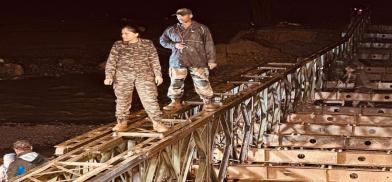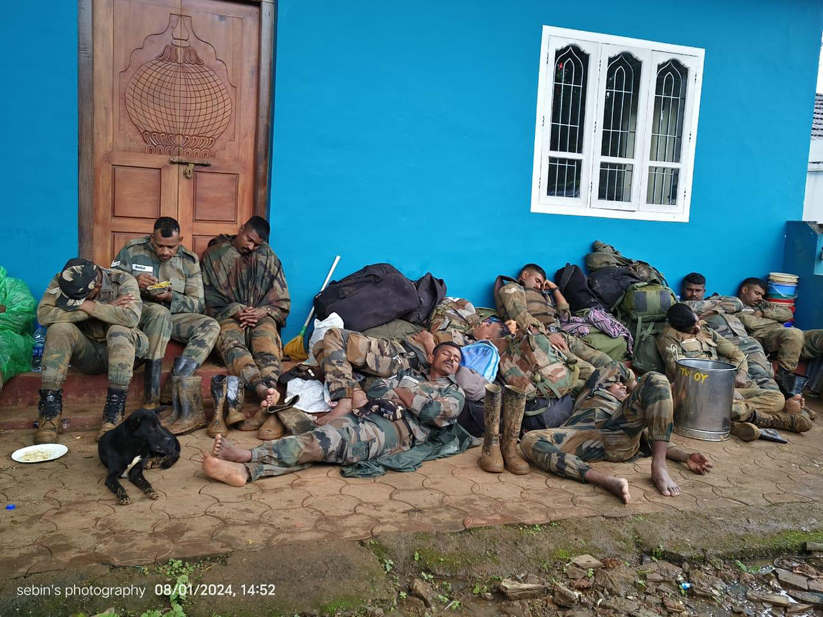Indian Armed Forces' stellar role in Wayanad disaster relief: Serving the nation in crises
What became a reason for special attention was that the Madras Sappers were led by a woman officer, Major Sita Ashok Shelke. This single-woman officer in a 150-strong team worked hands-on with the locals during the construction, planning the move of stores, approving the design and ensuring a safe, speedy launch. If the men kept awake for two nights, her responsibility required an even longer spell without sleep.

The Wayanad landslides turned out to be yet another classic example of the long-term apathy of some departments of the state administration. Deforestation which started in the 1980s to clear the land for tree plantation - and later for mining - is certainly one of the reasons. It is also reported that about 102 sq km and 196 sq km areas in Wayanad are extremely landslide prone and moderately landslide prone respectively with some locations also vulnerable to soil piping effect. Climatic conditions are expected to worsen in the future because of the emerging global warming scenario. The frequency of landslides is likely to go up in hilly regions.
The rescue and relief efforts also and not surprisingly, turned out to be largely by the Indian Armed Forces.
On 30 July 2024, inclement weather with heavy rains and landslides hampered the rescue efforts. According to NDRF (National Disaster
Relief Force) commander Akhilesh Kumar, rescue operations were paused during the night due to heavy rains and the threat of further landslides in the area. Six hundred NDRF teams were reportedly deployed in addition to over 50 teams from the Army, Navy, Air Force, and Coast Guard to take part in the relief operations. The Indian Army sent more than 200 personnel to the area to assist with search and rescue operations. Kerala's State Disaster Management Authority, Kerala Fire and Rescue Services, and Kerala Police, along with the Indian Air Force, Indian Navy, Defence Security Corps (DSC), National Disaster Response Force (NDRF), and volunteers participated in rescue operations.

On 31 July 2024, Indian Armed Forces were deployed to the area for rescue operations. A command-and-control center was set up in Kozhikode by the Army to coordinate humanitarian assistance and disaster relief efforts. Navy river crossing teams had also been dispatched. More than 4,000 people were rescued and over 10,000 people were sent to 93 disaster relief camps in Wayanad. Schools and colleges were closed in 10 of 14 districts.
On 01 August 2024, a 190-foot-long (58 m) Bailey Bridge was constructed by the 144 army men from the Army's Engineer Task Force of the Madras Engineer Group to connect the Chooralmala village with Mundakkai over the Iruvanipzha River within 31 hours.
Coordination and bravery
The Kerala government set up 45 relief camps in the Wayanad district, accommodating over 4000 people. The state health department also established a control room for assistance in case of emergency. Kerala Health Minister Veena George said that at least 1500 rescue personnel were deployed, including forensic surgeons. On 2 August 2024, the Indian Air Force deployed C-130 and drone aircraft from Hindon airbase in Ghaziabad, as well as a specialised team of experts for sub-soil evacuation and rescue monitoring. Forty teams of rescue personnel were divided over six zones consisting of Attamala and Aaranmala; Mundakkai; Punjirimattom; Vellarmala Village Road; GVHSS Vellarmala; and downstream of the Chaliyar River. Eight police stations along the Chaliyar River were also involved in the rescue efforts with regional expert swimmers. During the rescue operation in the Mundakkai village, advanced radars detected signs of breathing under the soil, however, in the evening it was determined it was more likely to be that of animals rather than trapped humans. Also on 02 August 24, the Indian Navy’s Advanced Light Helicopter (ALH) of INS Garuda operating from Calicut undertook aerial recce of the affected areas for survivors and locating bodies. The helicopter airlifted 12 state police personnel along with rescue equipment to the disaster locations, which were inaccessible by road. The sortie was conducted over the hilly terrain.
On 3 August 2024, in a remarkable display of coordination and bravery, the ICG, Indian Army, and Air Force successfully rescued three persons stranded at Soojipara Waterfalls, about 35 kms from Wayanad. During their morning combing operation along the riverbanks from Mundakai to Soojipara, the ICG search team sighted three individuals stranded near the waterfalls and immediately informed the control centre at Mepadi. Soon after, a coordinated land and air rescue operation was swiftly launched, involving ICG, Army, and IAF teams utilizing both ground and aerial resources, resulting in the safe rescue of all three personnel.
Lt Gen S Ravi Shankar (Retd), former DG, Border Roads Organisation, shared the details of this vital bridging operation with this writer. The most impressive and crucial task during the disaster relief operations was the launch of the Bailey Bridge, spanning 190 ft (57m), in record time, connecting Chooranmala and Mundakkai hamlets, to speed up rescue operations after the area was devastated by unprecedented landslides followed by floods, caught the attention of the nation for more than one reason. The equipment, including 80 tons of steel, with more than 300 major parts and innumerable bracing- members, connecting pins and fasteners, was moved from MEG Centre Bangalore to the Chooramal site by trucks, a challenging logistics exercise carried out with military precision. The bridge was designed after a spot reconnaissance by the team and launched as a continuous span of 57m, improvising for the tight ‘backspace’ using an intermediate pier at 15m from one end. Work was carried out tirelessly round the clock by the task force, to complete the bridge in 30 hours.
'Wonder Woman of Wayanad'
What became a reason for special attention was that the Madras Sappers were led by a woman officer, Major Sita Ashok Shelke. This single-woman officer in a 150-strong team worked hands-on with the locals during the construction, planning the move of stores, approving the design and ensuring a safe, speedy launch. If the men kept awake for two nights, her responsibility required an even longer spell without sleep. The picture of this woman officer standing on the truss of the Triple Single, 3 metres wide bridge, captioned by the media as the "Wonder Woman of Wayanad", went viral.
The earlier bridge in the location, since the 1940s, a 27.5m, twin span RCC bridge, 5.5m wide and capable of taking up to 100 tons load was washed away in the deluge, with no trace left. The gap widened to over 50m and is now covered by the new 57m Bailey Bridge, with a 3m wide roadway, supported by the intermediate pier, to enable it to take 24 tons. It allows relief material, and stores machinery and manpower to cross, limited by the maximum load. The bridge is still vulnerable to increase in water levels following heavy rains in the catchment area and so protective work using gabions (cages, cylinders, or boxes filled with rocks, concrete, or sometimes sand and soil for use in civil engineering, road building), are being made with the help of local authorities, to protect the pier and bank-seats. The provision of anchoring the bridge against lateral pressure of water will be an additional safety measure.
'Hail the Sappers'
“The response by the Army was commendable, improvising as best as they could and quite effectively too, using the available vintage Bailey Bridge equipment. The Bailey Bridge is a first-generation Modular Steel Panel Bridge (MSPB), considered amongst the three greatest technical advances that helped win World War II, along with the
radars , and heavy bombers……..Connectivity is the most critical requirement in any disaster relief operation and the Bailey Bridge continues to be used by us for emergency response. The world has since moved on to 3rd Gen MSPBs, capable of spanning 60m (200 feet), carrying 100 tons loads, and being launched as fast and with lesser
manpower. The Ministry of Roads and Transport and Highways is urgently considering a policy of stocking such bridges closer to where they are likely to be required in such emergencies. This will make emergency response more resilient in disasters, allow the option of use of an MSPB both as a permanent and a temporary bridge to carry the heaviest of axle loads and machinery presently carried on National Highways,” said Gen Ravi Shankar.
Brig AP Singh (retd.), another veteran Sapper who followed this operation, is reported to have praised the Indian Army Engineers personnel, “Hail to the Sappers at their best! Don't invite actors and Instagram celebrities as special guests in colleges. Encourage the students by inviting the ones who have served the nation in times of crisis like this.”
Work by all armed forces detachments is continuing in Wayanad and is expected to continue for some time. Yet again, what emerges is that despite creating national organisations for disaster relief, the armed forces are still indispensable.
(The writer is an Indian Army veteran who was a former spokesman for the Defence Ministry. He can be reached at wordsword02@gmail.com)
this blog, and I used to pay a visit this blog every day.
casino en ligne
At this time it looks like Expression Engine is the best blogging platform
available right now. (from what I've read) Is that what you're using on your blog?
casino en ligne
Hello to all, how is everything, I think every one is getting more from this website, and your views are nice in support of new viewers.
casino en ligne
This is a topic that is near to my heart... Best wishes!
Exactly where are your contact details though?
casino en ligne
Your style is unique compared to other people I
have read stuff from. Thanks for posting when you've got the opportunity,
Guess I'll just book mark this site.
casino en ligne
Your style is really unique compared to other people I have read stuff from.
Many thanks for posting when you've got the opportunity, Guess I will just bookmark this site.
casino en ligne
Oh my goodness! Incredible article dude! Thanks, However I
am going through troubles with your RSS. I don't know why I cannot
subscribe to it. Is there anyone else getting the same RSS issues?
Anyone who knows the answer will you kindly respond? Thanx!!
casino en ligne
If some one wishes expert view about running
a blog after that i propose him/her to pay a quick visit this webpage, Keep up the fastidious work.
casino en ligne
great points altogether, you just won a logo new reader.
What would you recommend about your publish that you made a few days ago?
Any positive?
casino en ligne
I don't know if it's just me or if perhaps everybody else encountering problems with your website.
It seems like some of the written text within your content are running off the screen. Can someone else please provide
feedback and let me know if this is happening to them too?
This may be a problem with my web browser because I've had this happen before.
Cheers
casino en ligne
Hi! Quick question that's totally off topic. Do you know how to make your site mobile friendly?
My weblog looks weird when browsing from my iphone.
I'm trying to find a theme or plugin that might be able to resolve
this issue. If you have any suggestions, please share. Thank you!
your weblog. You have some really great articles and I feel I
would be a good asset. If you ever want to take some of the
load off, I'd really like to write some articles for your blog in exchange for a link
back to mine. Please send me an e-mail if interested.
Regards!
I'm hoping to start my own site soon but I'm a little
lost on everything. Would you suggest starting with a free platform like
Wordpress or go for a paid option? There are so many options out there
that I'm completely overwhelmed .. Any tips?
Thanks a lot!










Post a Comment